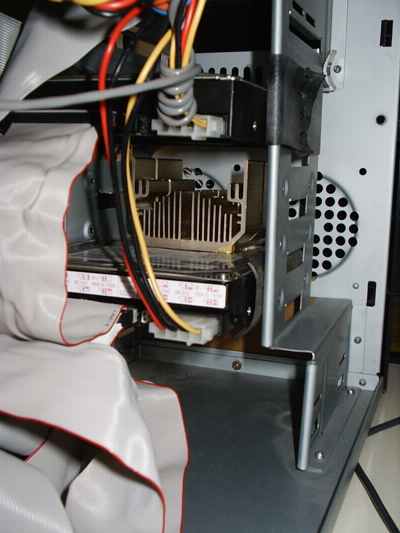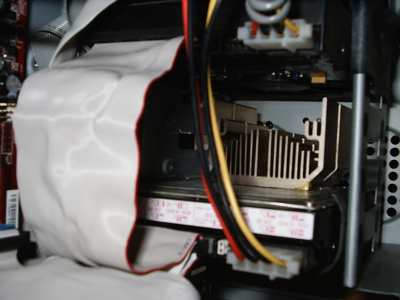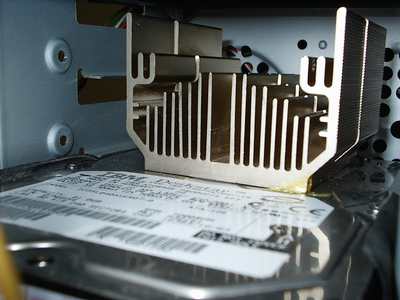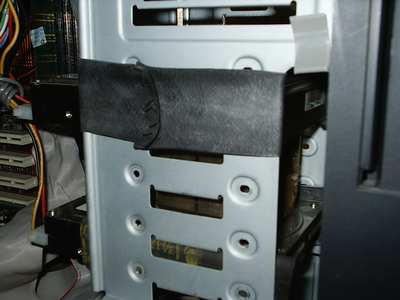Premessa
Someone might still not know the IBM Deskstar 60GXP fame, so here it is: when IBM released them, some years ago, mostly units among those with capacity of 60 GB failed (they were soon called "Deathstar"). This problem affected only the first stocks, but the name was compromised, even though every other product was fine (just check the reliability database, located at StorageReview.com).
I bought my 40 GB IBM Deskstar 60GXP before I heard the Deathstar fame, but I wanted to cool it a little anyway, since it was far warmer than my Maxtor 5400 rpm. As soon as I had the opportunity, I tried to do the best I could.
Construction
Recently, the CPU fan of an AMD Duron in a friend's PC broke down. The computer was still working well, but he decided to replace the assembly anyway, so we had a spare heatsink (we didn't found 6 cm fans alone). We decided to use that heatsink to cool down my HD, that had a temperature of 41°C when not used.
My first idea was to use a thermal compound to improve heat exchange from the HD metal surface to the heatsink. Thanks to IBM that didn't put paper labels on the full HD surface, like Maxtor does (maybe that could partially explain why Maxtors fail more frequently).
Initially, I thought that a rubber strip could have kept the heatsink well pushed to the HD and assured a good heat exchange. To keep the rubber stretched, I fixed it to the case, as shown in the photo:
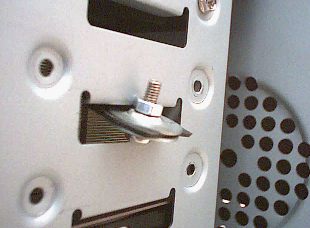
The strip was taken from a bicycle inner tube and it was cut by following the main circumference, in order to have it straight and not bended too much. I then made two holes on it, near the ends, to put a couple of bolts with washers on them: the bolts alone weren't large enough to grip enough on the rubber, they would have torn it apart. The following picture shows the rubber strip over the heatsink, actually it push it down pretty hard, keeping it in close contact with the hard disk. A bit of thermal compound is visible on a side.
To have the heatsink work as better as possible, it must have the fins aligned with the air flow (you can see the air holes in the picture).
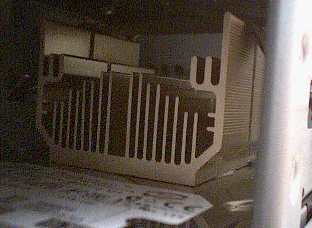
The result I obtained so far were pretty good: the idle temperature had fallen by about 2°C, from 40.5°C to 38.5°C. A that time I didn't do any other test, since I thought a greater temperature gradient between the hard disk anc the air could only improve the heatsink effectiveness.
Unfortunately, while the temperature decreased, noise increased. I thought about these possibilities: increased hard disk-chassis coupling, with more vibrations transferred from the hard disk to the chassis (the Deskstar 60GXP was one of the first 7200 rpm units, so it was much less refined than latest generation hard disks with hydro-dynamic ball bearings). Another one could be the rotation pivot, compressed by the heatsink (the rubber strip was VERY strong...). Once thought about this possibility, I decided not to risk and I removed the rubber strip, using a more traditional glue to keep the heatsink firmly attached to the hard disk.
The final result is showed in the first picture, followed by others with more details, useful to correctly position the heatsink: it should be put were there is the maximum heat production, possibly directly on the metal case and not on the paper sticks.
The pictures show some rubber put around the hard drives, you can read more about it on Hard drives noise damping.
The IBM Deskstar 60 GXP has always worked well since that day, only a bit noisier. Its temperature floats around 40-45°C, depending on the load.
All the temperature were measured with hddtemp, a free linux utility. Another useful linux tool is hdparm, it can set the hard drive seek speed on order regulated noise and useful life: hdparm device -M128..255. I decided to maximize the drive life, so I chose the least performance/least noise setting. Just to let you know... wen I tried to use the maximum performances setting with a Maxtor 5400 rpm drive (at that time it was the operating system drive, now it's broken, as every good maxtor :-/) I was able to obtain a 50% cut on Windows XP Home boot time! As side effect, however, the noise resembled a caterpillar!
If you'd like to have more details and infos, feel free to contact me by electonic mail.
Author: Olaf Marzocchi
